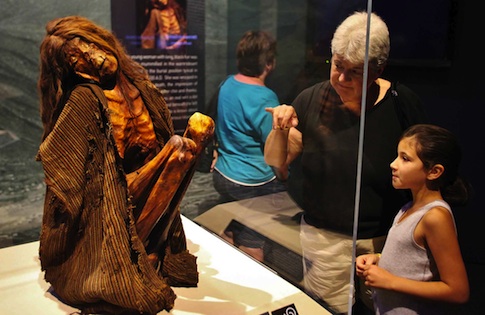A woman, her face desiccated by centuries of exposure to an arid climate and yet preserved by the frozen mountains of the Andes, rests with a baby wrapped in tattered cloth on her belly and another beneath her head.
The baby on her stomach is not hers. The child was placed on top of her about 200 years after her burial, by who we do not know. The other child beneath her shriveled pate … well, scientists aren’t really sure of its story.
"It’s clearly not a pillow," said Heather Gill-Frerking, director of science for the "Mummies of the World" exhibit.
The exhibit, fashioned around 20 mummies rediscovered in German museum vaults in 2004 after they were presumed lost or destroyed during World War II, opened for its final stop Sept. 28 at the Maryland Science Center along Baltimore’s Inner Harbor and will remain on display through Jan. 20.
The exhibit contains more than the popular bandaged corpses and sarcophagi from ancient Egypt. It displays about 150 objects, ranging from the mummy of an 8 to 10 month old Peruvian child who suffered from a congenital heart defect and lung infection and has been radiocarbon dated to about 4500 B.C., to a 100-year-old rat naturally preserved in a German attic.

Yet as you walk through the dimly lit rooms interspersed with dead bodies on illuminated platforms, you feel like something is missing.
One of the first items you see is a mummified foot. Where is its leg, torso, head? Probably cut apart and sold in pieces, according to the nearby text panel.
A fragment from the famous Egyptian Book of the Dead depicts a woman praying to the sky god Horus, who assumes the shape of a falcon.
So the sacrificed and mummified falcon nearby in a small, 1st century B.C. golden casket must be sacrosanct, right? Actually, X-rays show its bones are missing, described by the accompanying panel as an "ancient swindle."
I asked Gill-Frerking, a biological and forensic anthropologist who has studied mummies for more than 20 years, why these artifacts are rarely in one piece.
"Sometimes the dead are viewed as having an economic opportunity. That’s not a new thing," she said, referring to the use of mummies and their constituent parts for medicine, fertilizer, and train fuel.

Mummies have been plundered for centuries. Looting proliferated in Egypt during the tumultuous centuries following the fall of the Middle Kingdom in the 1600s B.C.
And the "swindle" of the dead continues. There are recent reports on the outskirts of Cairo of "a pock-marked lunar landscape with dense scatters of mummy wrappings pulled off bodies [to search for valuable amulets] and … limbs and heads of people who were buried here more than 2000 years ago." Another revolutionary period and lack of employment opportunities has again pushed Cairo residents closer to the pyramids and their ancestors.
Gill-Frerking said she has also heard about a Bolivian citizen who recently attempted to ship a centuries-old mummy to a French auction house.
"We really have to respect these people and what they teach us," she said. "It’s not okay to buy and sell them on eBay."